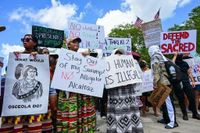On August 7, 2025, a federal judge issued a two-week pause on construction at the controversial immigrant detention center in the Florida Everglades, known locally as "Alligator Alcatraz." The decision, handed down by U.S. District Judge Kathleen Williams, marks a significant—though temporary—victory for environmental groups, the Miccosukee Tribe, and a coalition of advocates who have fought to halt expansion of the facility until its legal and environmental impacts are fully addressed.
The facility, built just two months ago on the grounds of the Dade-Collier Training and Transition Airport—a lightly used, single-runway airstrip—has rapidly become a flashpoint in Florida’s ongoing debates over immigration, environmental stewardship, and Indigenous rights. Capable of holding up to 3,000 detainees in temporary tent structures, the center has already drawn hundreds of migrants, even as construction crews continued to expand the site until the judge’s order.
Judge Williams’ temporary restraining order halts a broad range of construction activities for 14 days, including the installation of industrial-style lighting, paving, filling, excavating, fencing, and any expansion such as additional buildings, tents, dormitories, or administrative facilities. However, the order does not affect law enforcement or immigration enforcement operations, meaning the center remains operational and continues to house detainees.
The legal challenges center on two main issues: the environmental impact of the rapidly built facility and the rights of those detained inside. Environmental groups—led by Friends of the Everglades, the Center for Biological Diversity, and Earthjustice—argue that the project threatens the fragile wetlands of the Everglades, home to protected species like the Florida panther and the bonneted bat. They claim that the construction could reverse billions of dollars’ worth of ongoing environmental restoration, as reported by the Associated Press.
“We’re pleased that the judge saw the urgent need to put a pause on additional construction, and we look forward to advancing our ultimate goal of protecting the unique and imperiled Everglades ecosystem from further damage caused by this mass detention facility,” said Eve Samples, executive director at Friends of the Everglades, in a statement shared with the media.
But the environmental stakes are only part of the story. The Miccosukee Tribe has intervened in the lawsuit, asserting that the detention center was built on their ancestral lands without consultation, in violation of federal law and the tribe’s rights. The Big Cypress National Preserve, where the airport and detention center sit, is home to 15 active traditional Miccosukee villages. Ten of these villages are within a three-mile radius of the facility, and one—Panther-Osceola Camp—lies just 1,000 feet from its boundaries, according to Hyperallergic. The wetlands and swamps of Big Cypress are considered sacred by the Miccosukee, who were forced deeper into the Everglades in the 19th century and have stewarded the land for generations.
“The Miccosukee Tribe is committed to ensuring that our ancestral lands in Big Cypress will not become a permanent detention facility,” said Chairman Talbert Cypress in a statement. The tribe’s intervenor complaint emphasized that “hundreds, if not thousands, of protected ceremonial and religious sites are located” in the area. The lawsuit further claims that light and noise pollution, increased vehicle traffic, and other disruptions from the detention center threaten not only the ecosystem but also the tribe’s ability to conduct religious ceremonies and traditional medicinal practices, rights enshrined in the Everglades National Park Act and the Miccosukee Reserved Area Act.
Expert testimony in court has underscored these environmental and cultural risks. Soil physicist Christopher McVoy testified that at least 20 acres of asphalt have been added to the site since construction began, with tents, trailers, and heavy equipment brought in. Geologist Dillon Reio warned that the new paving could increase water runoff and spread harmful chemicals into adjacent wetlands, potentially disrupting the delicate balance of the Everglades ecosystem.
On the legal front, the state of Florida, represented by attorney Jesse Panuccio, argued that construction and operation of the facility are entirely under state control and that the National Environmental Policy Act (NEPA)—which mandates federal environmental review—does not apply. Plaintiffs countered that the facility exists solely to serve federal immigration enforcement and is, at minimum, a joint partnership between state and federal governments, making NEPA applicable. Judge Williams appeared to agree that federal involvement could not be dismissed, stating that the detention center was “at a minimum, a joint partnership.”
The lawsuit also highlights ongoing jurisdictional wrangling. Attorneys for the state and federal governments have asked Judge Williams to dismiss the case or transfer it, arguing that the Southern District of Florida is the wrong jurisdiction since the detention center is located in Collier County, not Miami-Dade County, even though the property is county-owned. As of the latest hearings, Judge Williams had not yet ruled on the venue question.
Meanwhile, a separate civil rights lawsuit looms. Civil rights groups allege that detainees are being held without charges, barred from meeting with lawyers, and denied bond hearings by federal immigration courts. A hearing in that case is scheduled for August 18. The state of Florida, in a recent court filing, stated that detainees have been allowed to meet with lawyers since July 15 and that “more meetings are taking place every day and there have been no complaints.”
Community response to the detention center has been swift and passionate. After Governor Ron DeSantis seized the defunct jetport under an emergency executive order in June, advocates and tribal members mobilized. Miami-based artist collective Artists 4 Artists hosted workshops and direct actions, aiming to “counter state-sponsored dehumanization.” On July 13, environmental organizations and tribal members held a public event at the nearby gallery of Big Cypress photographers Clyde and Nikki Butcher, spotlighting the region’s biological diversity and ancestral importance.
The temporary pause on construction, while significant, is just the latest chapter in a rapidly evolving legal and political saga. The DeSantis administration, according to multiple reports, is already preparing to build a second immigration detention center at a Florida National Guard training facility in the northern part of the state, with at least one contract awarded for what’s being called the “North Detention Facility.”
As arguments continue in federal court and the clock ticks down on Judge Williams’ temporary order, the fate of “Alligator Alcatraz” remains uncertain. For now, the wetlands of Big Cypress and the rights of those who call it home hang in the balance, as Florida’s detention policies face unprecedented legal and cultural scrutiny.



